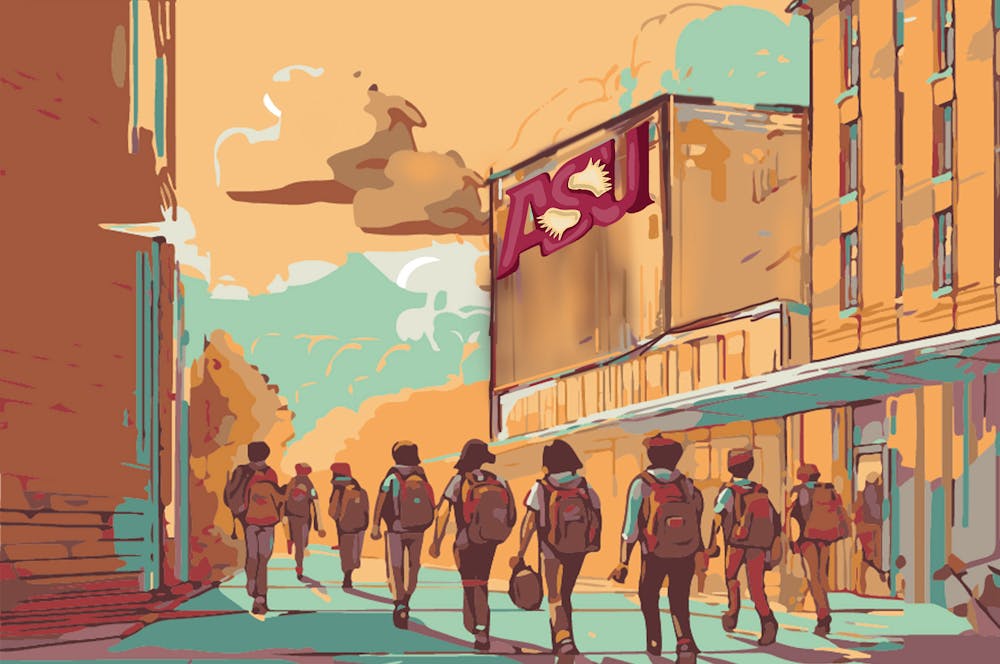Many students choose ASU as their first university to attend — or their second, third or fourth. College students transfer schools for various reasons, such as departure from community college, location, degree programs and more.
Data from 2022-23 shows that 7,926 new transfer students attended ASU, NAU and UA from Arizona community colleges. Fortunately, with steps and help along the way, ASU makes transferring an easy and accessible process for anyone.
"I wasn't sure if it was gonna be easy, but it wasn't even that bad," Giselle Esquivez, a junior studying fashion design, said. "I talked to my advisor, Greg, and he was super nice and very informative about what to do to transfer. I didn't have a problem with it at all."
Advisors help guide students through transferring and finding classes. Another guide is the undergraduate admission representatives, a different way for students to connect and ask questions.
A transfer applicant at ASU is considered someone who has attended one or more colleges or universities and has 12 completed, transferable credits post-high school. Students must have either earned their GED or graduated from high school.
The majority of transfer students come from in-state community colleges, according to Tanaya Dempsey, a director for the Academic Transfer Credit Solutions, a department in the Provost Office. She also said the majority of online students tend to be transfer students, an amount that is continuing to increase because of the opportunities and accessibility students have online.
Prior to becoming a Sun Devil, Esquivez had finished her community college studies at Phoenix College. She decided that attending community college before a university was the best choice due to financing.
"I realized how expensive (ASU tuition) was, and so, based off of financial reasons, I decided that community (college) was the best route for me," Esquivez said. "It was easier to just go out there first."
A transfer like Esquivez, Armando Gonzalez, a senior studying computer science software engineering, started his education at Estrella Mountain Community College. Estrella provided a cost-friendly way for Gonzalez to finish his prerequisites before enrolling in ASU.
Despite the big transition, Gonzalez found it easier to prepare for classes since some of his community college professors had already taught at ASU and tried to replicate the University classes. However, that can be hard with the population difference in schools.
"Class size here at community college is almost like a high school," Gonzalez said. "So your classes are maybe 20-30 people, and then at ASU, you've got lecture halls that have 100-plus students. So far, that's probably the biggest difference."
ASU attempts to provide a seamless transition for those migrating to a larger environment. According to Dempsey, ASU holds a database with 1.5 million course equivalencies from institutions worldwide, helping students get the proper credit coming in. ASU also offers over 400 undergraduate degrees.
READ MORE: Many ASU students change their major due to job market, workload
"If you are a student who is planning (to graduate) from your high school, and know you're going to go to community college, and then you eventually want to transfer to ASU, we have plenty of pathways to help students make those decisions," Dempsey said.
Students new to the University can join the Tempe Transfer Association, an organization currently on hiatus due to administration issues that helps new Sun Devils find a place at ASU by connecting with others who have transferred.
The club has held socials such as hiking A Mountain, attending ASU sports games together, grabbing dinner and getting boba tea.
"The goal of the Tempe Transfer Association is to help provide sort of a gateway for transfer students to become acclimated to ASU, both as a way to help them understand their academic opportunities at the school, what kind of resources they have, and also as a way to help meet people," Jefferson McGough, a junior studying civil engineering and the president of the organization, said.
For students wanting to become a part of ASU, there are several steps. Students wishing to apply must submit an application (students can also use the Common Application), activate their My ASU, submit a nonrefundable transfer application fee, and request their current college to send official transcripts to ASU.
For incoming transfer students, Gonzalez advised the future Sun Devils to make the most of the "crazy amounts" of resources ASU has to offer and to connect with their peers.
McGough voiced this same message, emphasizing that the large campus offers a wide range of people to befriend.
"There (are) people here of every single culture and ideology and anything you could possibly think of ASU, has it," McGough said. "So there are people here for you. Sometimes, you'll have to advocate for yourself, and that can be intimidating, but if you just jump right in, it's one of the most rewarding experiences of my entire life to come here."
Edited by Katrina Michalak, Walker Smith and Caera Learmonth.
Reach the reporter at sjames51@asu.edu and follow @sennajames_ on X.
Like The State Press on Facebook and follow @statepress on X.
Senna James is a Managing Editor at The State Press. She is in her 5th semester with The State Press working previously as Community and Culture Editor and Community and Culture reporter.




